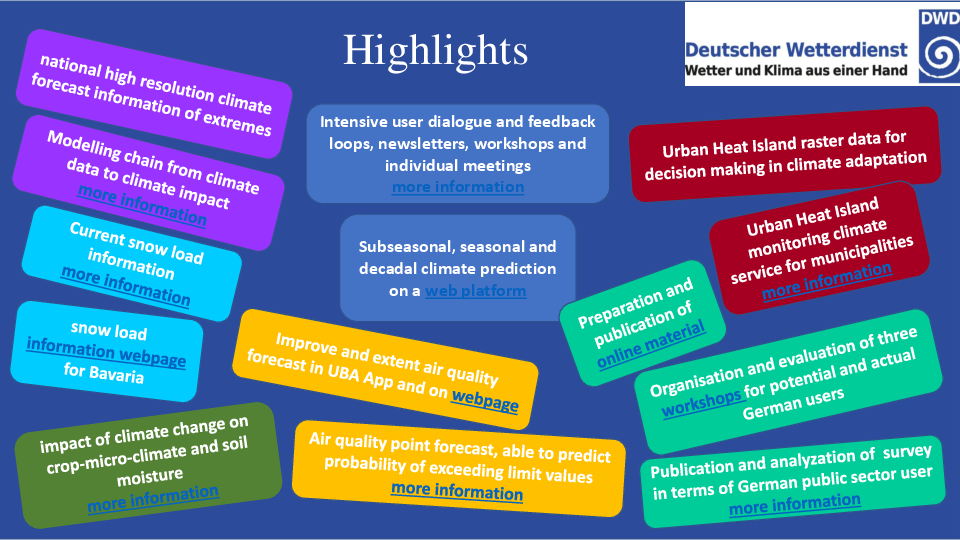Versatility of DWD contributions to FPCUP-Projects
In order to foster the user uptake of CAMS and C3S, the German meteorological service contributes to following aspects:
- set up a user-friendly seamless web information portal from subseasonal forecasts to climate projections for national downstream products focusing on German users;
- link the Copernicus Data Store (CDS) to CLIMADA, an open-source, probabilistic impact framework to provide seasonal to climate scale impact products;
- develop a C3S App for a Europe-wide provision of snow load climatological information for civil engineering as well as hazard and damage prevention purposes;
- provide an open access nationwide Urban Heat Island (UHI) dataset from 1995-2022 and an open access UHI-MAP climate service with visualized data including the impact of land cover changes and timeseries analysis;
- implement and operationalize a CAMS Downstream for providing an improved air quality forecast in Germany via a mobile phone app;
- generate maps of the normals and anomalies calculated for agricultural climate indices such as soil moisture and Providing the new products for regional to Europe-wide scales, easily accessible via a web portal;
- create awareness and knowledge about Copernicus data and services (CAMS and C3S) and stimulating cooperation, exchange of experiences and networking among actual and potential German users.
All activities help to close the ‘last mile’ of user uptake. The benefits for the user are:
Action 2019-1-52: Seamless Web
A new platform was created presenting a consistent evaluation and display of sub seasonal, seasonal and decadal climate predictions with focus on Germany in two different layers of complexity.
- 3,408 product plots have been published and product pages have experienced; ~54,300 accesses during the last reporting period.
- 165 (142) participants and 86 (69) participating institutions have visited the user workshop in May 2023 (June 2022).
- The website has been discussed with several users in individual user meetings.
More information:
- www.dwd.de/klimavorhersagen
- www.dwd.de/climatepredictions
- https://www.copernicus-user-uptake.eu/highlights/highlight-details/a-next-step-towards-seamless-climate-predictions-538
Action 2021-2-9: Responding to the Impact of Climate Change [U-CLIMADAPT] Develops a forecast of user-relevant impact indicators and integrates it in operational service for finally being able to use Copernicus data for providing seasonal to climate scale impact products
- Ability to generate maps with climate extreme indices, e.g. number of heat days
- Engagement of ETH Weather and Climate Risk working group and active global CLIMADA Modelling Community into seasonal forecasting activities.
More information:
Action 2021-2-37: Estimation of snow load data using Copernicus and in-situ data Provides climatological snow load information and implements a downstream service for pilot regions
- The first version of the pilot downstream service for snow load in Bavaria is nearly finished.
- Related stakeholders in pilot regions are being identified.
- User survey: 70 participants (11.12.2023).
- Creation of a snowload DWD Website: over 1100 call ups (11.12.2023).
More information:
- https://www.copernicus-user-uptake.eu/user-uptake/details/estimation-of-snow-load-data-using-copernicus-and-in-situ-data-531
- https://www.dwd.de/DE/leistungen/schneelast_info_bayern/schneelast.html
Action 2020-2-25: Mapping and monitoring of km scale urban climate impacts due to changes in land cover and atmospheric conditions Provides an open access urban heat island (UHI) monitoring climate service for municipalities and decision makers to assess current and past UHI of their area of interest.
- 1st User Workshop on DWD Climate Services for Urban and Regional Planning (DWD Offenbach on-site, 04.05.2023)
- EU survey questionnaire and beta-tester
- Participation in two international conferences 11th ICUC Conference (Sydney) and Beating the Heat Conference (Zürich)
- 2nd User Workshop (DWD Offenbach on-site, in preparation April 2024)
More information:
Action 2018-1-46: CAMS Downstream – Development of a LQ-WARN – App Developed and compared approaches for a downstream of air quality forecast for providing those via a mobile phone app.
- successful development and operation of the MOS-approach (Model Output Statistics) for improved air quality forecast
- ozone and PM10 forecasts are operational and published , NO2 and PM2.5 forecasts and forecast for traffic stations (relevant only for PM, NO2) are in preparation (release soon)
- total number of app downloads: about 150.000
More information:
- https://www.umweltbundesamt.de/en/data/air/air-data
- https://www.umweltbundesamt.de/themen/luft/luftqualitaet/app-luftqualitaet
Action 2020-2-8: Agrometeorological Modelling Based on Copernicus Regional Reanalysis Data Investigates the impact of climate change on crop micro-climate and soil moisture and make it accessible in a web portal.
- The project is still in its initial phase.
- Effects of different input data on the model have been evaluated.
More information:
Action 2018-1-98: Illustrate, demonstrate and disseminate information about Copernicus data and services for different application domains Increases the awareness and knowledge about Copernicus as well the networking between the users in Germany.
- Production of user-friendly brochure “Die Copernicus-Dienste Klimawandel und Atmosphärenüberwachung“
- Demonstration of use cases and good practices in the application of Copernicus services C3S and CAMS with focus on public sector users in Germany
- Performance of three workshops with organization of working groups involving different user groups and user-for-user presentations
- Wider dissemination of results and promotion of take-up by online and offline publications
More information:
- https://www.copernicus-user-uptake.eu/user-uptake/details/illustrate-demonstrate-and-disseminate-information-about-copernicus-data-and-services-for-different-application-domains-26
- https://www.copernicus-user-uptake.eu/resources/resource-details/die-copernicus-dienste-klimawandel-und-atmosphaerenueberwachung-564
- https://www.copernicus-user-uptake.eu/resources/resource-details/presentations-of-the-third-workshop-on-the-use-of-copernicus-services-548
- https://www.copernicus-user-uptake.eu/resources/resource-details/presentations-on-the-use-of-copernicus-services-466
- https://www.dwd.de/DE/klimaumwelt/klimaforschung/klimawirk/stadtpl/stadtklimaprojekte/projekt_fpcup_illdemdis/fpcup_node.html


